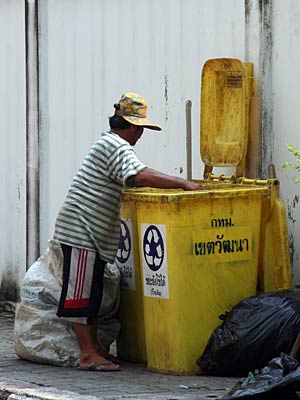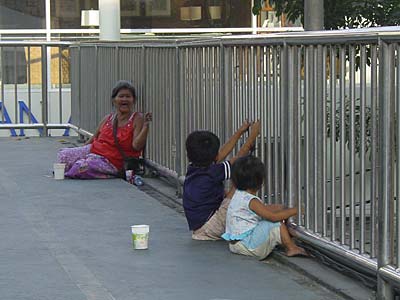Basic Economic Realities
We are not going to talk here about how the Stock Exchange of Thailand (SET) has risen or gone down. Simply speaking, the Thai economy is in a holding pattern. Growth since the 2008 financial crisis has basically remained subdued, at least partly due to a persistent political crisis. There is substantial investment in infrastructure projects, but the implementation of these projects are often faced with additional problems and delays.
We just want to tell you what is visible on the streets of Bangkok and indicates lack of improvement in basic living conditions for a proportion of the population.
Now in 1997 we had the major Asian economic crisis, initiated (or followed) by a major devaluation of the Thai currency and other currencies in Asia. Some foreigners living in Thailand will probalby never forget what occurred and lost a lot of money in the process (if they had deposited Thai baht in the banks, it almost lost half its value overnight). Many financial institutions (there were actually too many of them around anyway) went broke, banks accumulated a lot of non-performing loans. Business profits and the Stock Exchange of Thailand went down. Hundreds of property developments around Bangkok were halted. Some remained standing for longer than a decade thereafter.
We thought from the beginning that about 5 years would be needed for a restart of the economy and that is what happened. That is, company profits improved, banks started lending again, the Stock Market rose.
How did this translate into the daily life of people in Bangkok since then? What we did notice however is a deterioration in the living conditions of a minority of Bangkok inhabitants, which actually reflects very badly on the impression visitors must have when spending some time in the country. Even now, in 2021, we notice effects of poverty in the street, which were not that apparent in the mid-1990's of the last century.
People go to some lenght to make a living. So the number of food stalls and vendors on the pavements has ever increased, often blocking the pavement. After all, with little education, there is always the possibility of cooking some food, or peddling some merchandise. As another example, we noticed that in our soi off Sukhumvit where we live, at least 10 (=ten) establishments are providing massage services, some offering legit traditional massage only, others mixing regular massage with 'additional' services. In the early 1990's, one had to go all the way to Silom road, from Sukhumvit road, to get a traditional Thai Massage, now you can walk down any soi and find services (though with less qualified masseuses).
What is new to Bangkok streets after 1997 and after the 2008 financial crisis, are some characters in the street that were not noticeable before. Examples :
The garbage scavenger :

Garbage scavengers have become a common sight on the Bangkok streets. They offer a cheap way of recycling garbage, though we do not exactly think the job is something to look forward to.
Garbage is collected regularly in Bangkok, mostly during the night. In the evening hours, before this occurs, it is common to see garbage scavengers going through the garbage deposited in big bins and plastic bags by the side of the road. This is obviously a lowly profession, but they perform a useful task : recycling garbage. Fortunately for them there is actually some money in collecting glass bottles, aluminium cans and paper. The local staff at condominiums actually make some good pocket money by collecting the newspapers from the building and selling them for recycling. An aluminium can (like for soda drinks or beer) gets half a baht, which is actually not bad at all. Of course, having these garbage scavengers go through the garbage at night is rather unseemly. We admit that the last few years, garbage scavenging has decreased. As for separation of garbage into different categories, not sure much of it happens.
The homeless :
Every sidestreet on Sukhumvit road seems to have about one homeless person (or a couple) roaming the street, spending the day on the pavement begging, or just lying around, often in drunken stupor. They usually are hardly dressed, completely tanned from staying in the sunlit streets. Some of them are actually well fed. We remember seeing one particular young man staying in soi 19 (he is now gone) who was quite obese and used to get his food (at least partly) from taking it from the offerings at the little religious shrines that are common in front of large buildings. This is actually quite preposterous and against all the norms, but he clearly got away with it. We think the homeless are sometimes rounded up by police, but after a while they simply come back, or someone else takes their place. From our experience, we have noticed people living on the street for many years, sometimes finding some manual work on occasion.

Beggars on a pedestrian bride over Sukhumvit Road.
The beggars :
There are really a lot of beggars all over Sukhumvit road sitting on the pavement in between the vendor stalls. They mainly seem to target tourists. Some of them at least likely operate as gangs, and have some organization. It is certainly so that one can not just pick a spot and start begging. There is some control and one certainly needs permission (and needs to pay commission or whatever one may call it) from some controlling 'authority'. Very often, the beggars do not appear to be ethnic Thais (we admit not being an expert in distinguishing between various Asian races, but we have some capability). Rather they may have Cambodian or Burmese roots. From all we know, begging is allowed on the streets of Bangkok and nothing much is done to reduce its occurrence. On the contrary, the number of beggars seems to be ever increasing. The most impressive performance (this is in bad taste, we agree) is given by the crawlers, often with amputated legs, that go about sliding over the pavement in between the vendor stalls on the crowded pavement. Children are being abused for begging (see further). A few years back, beggars were taking from the streets by authorities, and even transported over the border with neighboring countries. But as of 2021, they are again occupying selected locations on the pavement, and most seem to be of foreign origin (as far as we can judge that).
Child labor :
We do not know about the labor laws. We assume that there are laws against child labor and child abuse in Thailand, but somehow not much seems implemented, when observing what is happening on the Bangkok streets. A lot of beggars drag around their very young offspring, and use them as bait for tourists. Some youngsters sometimes not older than 18 months or 2 years old are 'deposited' with a tin can in front of them on the side of the road, with an observing adult watching over them from closeby. They spend hours on the pavement in the day heat, and up to midnight and later.
Somewhat older youngsters are engaged as child labor attempting to clean car windows at traffic lights, though occasionally they disappear for a few months. There sometimes is a whole group of them at the Sukhumvit-Asoke intersection. They jump in between the cars cleaning windows when the light is red and car owners often oblige by giving them some pocket money. When the traffic moves, they casually keep on walking in between the moving cars. We wonder how many a year get maimed or killed doing this job.
If you ever walk through Soi Cowboy or past the entrance of Nana Plaza entertainment (soi 4), you will notice a lot of young girls (aged from 4 years old and up) selling flowers to touists visiting the nightlife scene in Bangkok. For all we know, authorities have tried to stop the most squalid of performances at the bars, and there are restrictions to full nudity at some places, but there seem to be no qualms about allowing children to spend the night there trying to make money for their minders.
The Prostitutes :
It is not the whole story, but at least we assume that people prostitute themselves often because they do not find a suitable alternative way of employment. Thailand has a well earned reputation as a destination for tourist looking for cheap paid sexual services. Despite crackdowns a few years ago, the number of bars and women catering to tourists and local residents, seems to be ever rising. Thailand must be one of the few places in the world were there are entertainment venues solely targetting foreign visitors looking for prostitutes.
What was not present before 1997, is the abundance of prostitutes (females and persons of undetermined sex) roaming the pavement at night. Lower Sukhumvit may have quite a few prostitutes just sitting around, and accosting potential customers walking by, also during the daytime.
During the daytime (but also at night) there are also quite a number of pimps annoying male passers-by with colorful pamplets of venues where women perform 'full body massage' services.
When talking about the sexually oriented entertainment industry in Bangkok, we should also mention that on the sidewalk of Sukhumvit, in between the clothes vendors, food stalls, and fake watches, there can be stalls selling pornographic material. Lately there are less pornographic videos on sale (probably everybody checks out things online nowadays), but there is an active trade in real or fake sexual stimulants, not sure if they are all still working after some time under the Bangkok sun. Various dildos may also be on sale. People just making a living, but not exactly what a visiting family with young kids wants to have around, when having a leisurely stroll.
All the above goes to show that all is not well in the Thai economy. Business profits may be up, and the government is certainly doing efforts to relieve some effects of poverty, and to improve the income of low earners. But quite a few people seem to still lead a rather miserable life. We want to reiterate that the above (except for beggars and the active nightlife) were not present say 20 years ago, and their presence now suggests the conditions of people at the lowest steps of the economic ladder, has not improved a lot.

